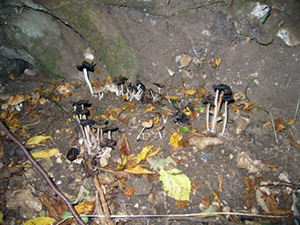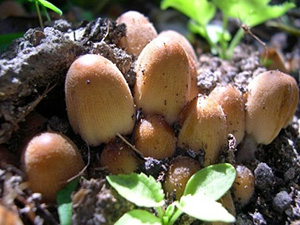Event Reports for 2005
GARDENING FOR WILDLIFE - 10th February
'That's not a weed – it's a Native Species!'
A packed house enjoyed a fascinating evening.
A change of venue did not throw off Lynsted with Kingsdown Society members as they gathered, with some Norton gardening friends, in Norton Village Hall on 10th February. Dynamic 'Swale in Bloom' duo Sallie and David Shaw used slides to illustrate some of the simple tricks for enticing bees, butterflies, birds, frogs and small mammals into the garden. They explained how, collectively, domestic gardens have become a vital refuge for wildlife driven from the land by intensive farming methods. We could all do our extra bit by not being quite so tidy, and by providing simple shelters for small creatures. Elizabeth Care followed up by explaining the excellent Gardening for Wildlife award scheme - a 'free entry' scheme that several members signed up to there and then!
A period for questions and comments allowed a local farmer to explain that certain farming methods were not so 'wildlife unfriendly'. But 'Br'er Rabbit' remained beyond the pale for many in the audience!
Kent Wildlife Trust ("Wild About Gardens") have some guidance on how to make your garden as friendly a refuge for wildlife as possible.
Bob Baxter (Chairman)
READING A CHURCH - 12th March
Kent History Federation Events are open to our Members. Amanda Strevens attended and reported on this fascinating topic. An all-day event at St Helen's Church Cliffe at Hoo. Professor Nigel Saul, distinguished medievalist at The Royal Holloway College.
"Members of the Lynsted Society were invited to a lecture entitled "Reading a Church" on the 12th March, which was staged by the Churches Committee of the Kent Archaeological Society. Around half a dozen people went to this extremely well attended event and felt very privileged to be able to listen to Professor Nigel Saul, a distinguished medievalist from the Royal Holloway College.
The day began at 10.30 a.m. with an introduction given by Philip Lawrence, Chairman of the KAS Churches Committee, and then the stand was taken by Professor Saul who began his talk with an explanation on the origins of a Parish with an emphasis on Cliffe. However, Professor Saul's ability to name churches all over the country when giving examples of particular features was quite outstanding as indeed was the quality of the whole talk.
The first part of the talk concentrated on how population and wealth determined the size and style of churches, with for example the Black Death in 1340 resulting in something of a paradox as, although the population was reduced by one third to a half, a lot of building went on because of the increase in wealth. The Romanesque style was taken over by the Gothic in the late 12th century and Professor Saul drew on examples in northern France and in this country, such as St. Denis near Paris and Kings College, Cambridge and St George's Chapel, Windsor. However, in the time of the Reformation, the building of churches came to an abrupt halt and the layout of them was hugely changed due to the shift of sacramental religion from the altar to the pulpit. We learned that the Reformation was then followed by two centuries of decay and neglect until the Victorians, revelling in the riches of the Industrial Revolution, began their own building program, rejecting the Classical and creating the Gothic Revival style and existing churches were altered to accommodate the new style, although perhaps not necessarily to the benefit of the building. It was the Victorians who created the appearance of the modern Church of England.
All the people present then enjoyed a delicious lunch, which was laid out on tables at the west end of the church. The lecture then continued in the afternoon with Professor Saul concentrating on various features of all churches, and St Helen's in particular. He discussed wall paintings, glass, monuments, the font, the pulpit, and the basic structure, such as the existence of transepts and the importance of the growth of the nave, which used to be smaller than the chancel.
Secretary to the Society
DERIVATION OF PLACE NAMES - 15th April
Lynsted Community Room was filled to overflowing on the evening of April 15th as members and friends of the Lynsted with Kingsdown Society met to listen to a talk on Place Names in Kent. It has been said that place names are a 'window' into where and how people lived and viewed their homesteads in ancient times.
Dr. Paul Cullen, who is on the staff of the Institute of Names Studies at the University of Nottingham, is far from being the prototype of an academic lecturer. This young, colourful, speaker immediately shared with us his obvious love of Kent and his subject. The talk, well illustrated with local photographs, explained, to an appreciative audience, how many of the villages and hamlets came to get their names. For example, Kingsdown comes from "dun", meaning a hill and Syndale contains "dael" which means a valley. Many Kent names are of Anglo-Saxon origin and a few are Celtic and were named after local features of the Kent countryside which are still to be seen today as he clearly illustrated with his photographs.
He started the evening by recommending a number of different books that could be useful to the Society in any future research projects members might undertake. As the current leading authority on place names of Kent he is in the process of compiling his own reference book, which we look forward to reading at a later date. (This may not be in the immediate future as he is juggling many balls in the air at present!)
I am sure that everyone present at Paul's talk will agree that his enthusiasm for this subject inspired us all in our thirst for local knowledge.
We hope to invite him back at a future date to do some 'hands-on' research with us on the immediate area.
I will add that we were relieved to learn that Lynsted does indeed mean 'place of the limes', is derived from the word "stede" meaning "place". So the lime tree planted for the Jubilee celebrations will not have to be replaced by something more appropriate!
Norma Baxter
TOUR OF KINGSDOWN FARM (was part of Hole Street Farm) - 15th May
Environmental Management in Farming
Their Introduction: Neil and Jenny welcomed us to Kingsdown Farm. "We thought it would be helpful to have a short explanation of the on-going programme for wildlife encouragement and protection on our farm. Beginning in 2001, with funding from the Countryside Stewardship Scheme, Neil began planting 1500 metres of hedgerows, both new hedges and gapping up existing ones. He also planted around 400 trees in various corners, and one small spinney (Josh's Wood}. As well as tree planting, 1200 metres of 2 metre wide grass field margins and over 6000 metres of 6 metre wide grass field margins were established.
The margins are sown with a seed mixture, which includes tussocky grasses such as Timothy, Cocksfoot and Fescues. It also contains wild flowers such as Cowslips, Selfheal, Wild Marjoram, Birdsfoot Trefoil, Common Knapweed, Kidney Vetch, Red Campion and Woodsage.
These margins are designed as wildlife corridors linking woods and hedges, and to provide food for insects, small mammals, bats and the bird population. The latter includes a colony of Tree Sparrows at Park Farm.
The following year it was possible to include the old cherry orchard at Park Farm in the scheme and some arable options, including 7 acres of wild bird seed mix, conservation headlands, overwintered stubble and 10 acres of rotational fallow.
The Countryside Stewardship scheme is funded by DEFRA and acceptance is merit based. In order to qualify, the land has to potentially provide habitat for endangered (BAP) species, and protection of threatened habitats - in our case, the local bat colony, the Tree Sparrows and the old orchard.
More than twenty members gathered at Hole Street Farm, Kingsdown, for what turned out to be a most enjoyable and instructive farm walk.
We strolled in (unexpected) warm sunshine as Neil Anderson explained how he was taking advantage of farm legislation to encourage wildlife through creating hedges, headlands, 'beetle' banks and skylark nesting areas. He explained how he was using a 'minimum tillage' scheme that avoided the damage to soil fauna caused by conventional ploughing. Native wild flower species were being encouraged in the non-crop areas, and cowslip, red campion and knapweed were already in evidence. The pollen and nectar produced by these were 'top of the food chain' and resulted in greater insect, and therefore bird, numbers. A spinney of native trees had been established, to provide additional habitats. The Countryside Stewardship scheme and funding that Neil had successfully negotiated, also covered parts of Park Farm, including the Community Cherry Orchard.
The group proceeded, firing questions at a host who clearly knew his business, to Erriott Wood. Here a rotational scheme of sweet chestnut coppicing was providing a sequence of further habitats. The carpet of bluebells in a recently cleared area was magnificently Kentish. Neil reminded us all ,though, that the environmental work could not be done without the income from conventional crops. His included cereals, oilseed rape and linseed.
Retracing our steps, and enjoying several sightings of hares, we returned to a delicious tea and cakes 'spread' kindly provided by Jenny.
It was a delightful way to spend a spring afternoon, and the Society is most grateful to Neil and Jenny for their hospitality.
Bob Baxter.
TENTERDEN VINEYARD VISIT - 11th June
A talk, tour and tasting of wines from Tenterden Vineyard. Most Members travelled on a green Leyland Titan P.D.2. Double Decker bus of 1948 vintage - this model was first launched in 1927. Driven by the owner, David Powell.
On a fine Saturday morning in June you may have caught sight of three groups of excited people, in various parts of Lynsted, waiting eagerly for a sight of David Powell's green, vintage, double-decker Leyland bus.
Members and friends of the Lynsted with Kingsdown Society were off to enjoy the Kentish countryside scenery, viewed from a higher than normal vantage point. An hour after leaving Lynsted we arrived at Tenterden Station for a short break. We quickly dispersed into the busy High Street and for the next hour could be found in various locations having a cup of coffee, visiting the Nelson exhibition in St. Mildred's Church or enjoying some retail therapy.
By 1pm the 'bus had taken us a few miles further on to Chapel Down Winery where we met up with a couple more Society members. Here, after a leisurely lunch on the newly renovated picnic site, we all went for a guided tour of the vineyard to learn why Kent is now an internationally respected wine producing area. We saw the acres of grapevines stretching into the distance over the gently slopes of the Weald. At present, most of the grapes grown are German varieties but we were told that this might well be changing. As a result of global warming some of the French grapes (e.g. Chardonnay) are now able to ripen in the Kentish climate.
We then went on to see the giant stainless steel press (which only operates for three weeks, in October) and marvelled at the numerous, enormous storage tanks in which the white wine stays before it is bottled and sent on for sale. One of this vineyard's specialities is sparkling wine. The method of its production, we were told, has been modelled exactly on the chemical and physical processes used in the Champagne region of France.
Some red wine grapes are also grown at Tenterden and we also visited a room full of neatly stacked oak barrels full of maturing Kentish red wine.
Finally, of course, we were invited to taste five different wines (white, sparkling and rosé) being a few of the many different varieties made at the vineyard.
The outing was completed by yet another local treat as we all trooped up the narrow staircase from the vineyard shop into a light, modern restaurant for tea served with a home-made scone (or two!) strawberry jam and cream.
Having made various purchases in the Shop thirty very contented people climbed gratefully onto the double-decker for the journey home. Thank you David for sharing your beautifully maintained' bus with us and for driving us so well along the country roads of Kent.
Norma Baxter
EARLY AVIATION ON SHEERNESS - 9th September
An illustrated talk ("Early Birds") by Bill Croydon about the role of Sheerness in the early development of aviation that challenged even the stories of Orvill and Wright!
Did you know that some of the very earliest manned flights took place not eight miles from Lynsted? That Eastchurch, Sheppey was chosen as suitably out of the way by those crazy young men determined to show that a heavier-than-air machine could really transport a man with bird-like ease? If not, and if you would like to know more, then allow me warmly to invite you to our next lecture: 'Early Birds'. The speaker - Bill Croydon, an ex-aviator himself, gave an illustrated and gripping tale of tragedy and triumph that was enacted in this part of Kent – and beyond! The talk took place in Norton Village Hall.
FUNGUS FORAY - 9th October
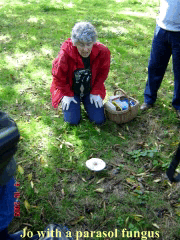 Starting in the Community Orchard, Park Farm and then Toll Wood, Jo Weightman, a leading expert, organised a day of searching for and identifying mushrooms and toadstools around Lynsted. Also look at the Toll Wood Survey of 2000-2001 (reproduced below).
Starting in the Community Orchard, Park Farm and then Toll Wood, Jo Weightman, a leading expert, organised a day of searching for and identifying mushrooms and toadstools around Lynsted. Also look at the Toll Wood Survey of 2000-2001 (reproduced below).
A fair crowd followed Orpington-based fungi expert Jo Weightman as she ranged through the Community Orchard at Park Farm, Lynsted, on Sunday 9th October.
The occasion was the Lynsted with Kingsdown Society's 'Fungus Foray'. The weather was bright, and Jo deployed the ten children in the party to good effect – their eyes were sharper and closer to the ground than those of the twenty-two adults! Despite it being a poor year for fungi because of the dry weather, Jo and her 'team' of enthusiastic amateurs, large and small, managed to locate no less than 19 species! Some were growing on living trees, some on dead wood and some in the grass. Cameras clicked busily. Jo was able to allocate the Latin name to every specimen found, and to explain all about its biology, and use. The group was surprised to learn, for example, that the black pigment in disintegrating 'ink cap' mushrooms was regularly used in ink production in times past.
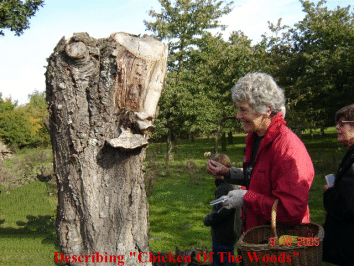 Moving on to Toll Wood, sixteen more species were identified. Jo made no excuse for using the systematic, Latin, names for the species. We British, in contrast to our Continental cousins, have little tradition for harvesting various fungi for the table, so common names are unusual. Even so, the few that had names were quite expressive: 'chicken of the woods' (see photograph below), 'cramp ball', 'oyster fungus', 'Jew's ear'….
Moving on to Toll Wood, sixteen more species were identified. Jo made no excuse for using the systematic, Latin, names for the species. We British, in contrast to our Continental cousins, have little tradition for harvesting various fungi for the table, so common names are unusual. Even so, the few that had names were quite expressive: 'chicken of the woods' (see photograph below), 'cramp ball', 'oyster fungus', 'Jew's ear'….
Pleasantly fatigued with the scramble around the tree trunks and the walk between 'sites', the survivors returned to the Community room. There, after a hand-wash (some fungi being very poisonous), the party enjoyed a tasty ploughman's lunch kindly prepared by Myra Scott and Mandi Strevens. Everyone was pleased with what had been a most enjoyable and illuminating Foray.
The Society is grateful to Pip Neaves and Lisa Candy for permission to access their land. You can compare the results of a survey of Toll Wood in 2000-2001.
Bob Baxter
Jo Weightman's Additional comments on Park Farm Orchard - the community orchard.
As would be expected most of the fungi seen were Basidiomycetes, having spores which fall into the air rather than being forcibly ejected from the fungus. Two of these, the Ganoderma and the Laetiporus are parasitic fungi, although in this instance they were fruiting on the dead stumps of trees they may previously have killed. The two powdery mildews recorded are also parasitic species, occurring on living leaves. All the rest were saprophytes, i.e. feeding on the already dead substrate of tree stump, fallen branch or rotting plant material.
Interest was centred on the dead wood lying on the ground and the orchard management is to be congratulated on its policy of keeping this material on site. Fallen wood species included brackets, crusts and gilled fungi (agarics), the latter ranging from white to pink to black-spored examples. Grassland fungi were few in the prevailing drought conditions but it was interesting to see Clavaria vermicularis, a species of unimproved grassland, which may indicate the presence of a range of grassland species present but not fruiting on the day.
| Latin Name | Common Name | Association | |
Community Orchard |
|||
| Basidioradulum radula | Toothed crust fungus | on dead cherry | 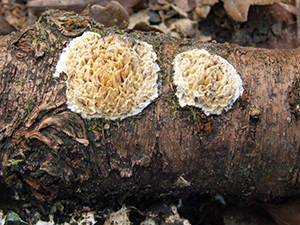 |
| Clavaria vermicularis | White Worm Coral fungus | in grass | 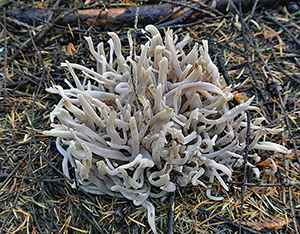 |
| Collybia cirrhata | on debris | ||
| Collybia erythropus: Normal size less than 5 centimetres. Habitat often in tufts, in leaf litter of deciduous woods. Season autumn. Unusual. Found in the Community Orchard | Redleg toughshank | on dead cherry logs | 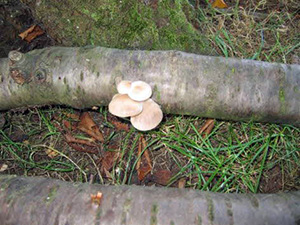 |
Coprinus micaceus: Coprinus species are commonly known as ink caps. They are very common but, unlike many toadstools, tend to be short-lived, growing rapidly on a range of substrates such as straw, woody substrates and dung. Images: top one from Toll Wood; other one elsewhere in the Parish - emerging |
Glistening ink cap | on dead cherry |
|
| Coprinus plicatilis | in grass | 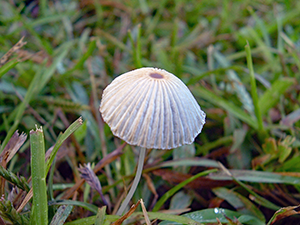 |
|
| Erysiphe urticae on Urtica dioica (powdery mildew on stinging nettle) | |||
| Ganoderma adspersum | on dead cherry | 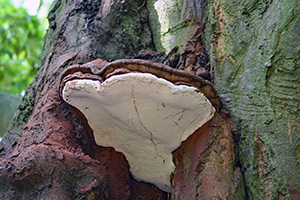 |
|
Laetiporus sulphureus: looking sorry for itself or 'gone over' in the local dialect! Not at all edible in this state! When young, they are yellow, orange. Habitat deciduous trees, usually oak but common also on yew, cherry, sweet chestnut and willow. Season late spring to autumn, annual. Common. Edible when young and fresh, considered a delicacy in Germany and North America. Found in the Community Orchard |
Chicken of the Woods, Polypore soufré, Schwefelporling, Sulphur Shelf. | on dead cherry | 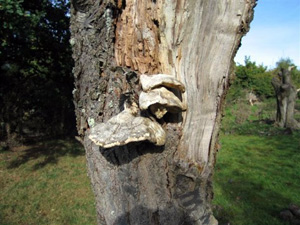 |
| Macrolepiota rhacodes var. bohemica: A parasol variety that is often found on rich soil in gardens and compost heaps. Season summer to autumn. Frequent. Found in the Community Orchard | parasol | 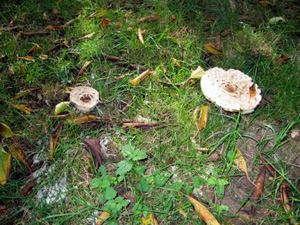 |
|
| Panaeolus sp | probably on dung | ||
| Phlebia radiata | on dead cherry | ||
| Pleurotus ostreatus | oyster fungus | on cherry logs | 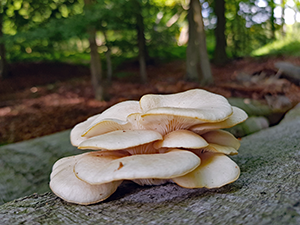 |
| Pluteus cervinus | Deer shield | on dead cherry logs | 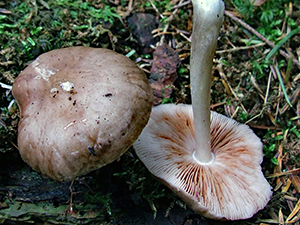 |
| Psathyrella sp | |||
| Trametes gibbosa: A bracket fungus sometimes called the "Lumpy Bracket". Quite commonplace. | lumpy bracket | on dead cherry | 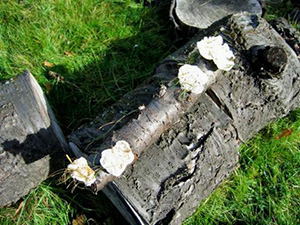 |
| Trametes versicolor: A bracket fungus sometimes called the Turkeytail. | on dead cherry | 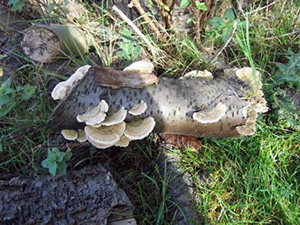 |
|
| Uncinula bicornis on Acer campestre (powdery mildew on field maple) | |||
Toll Wood |
|||
| Auricularia auricula-judae | Jelly ear fungus | on dead elder | 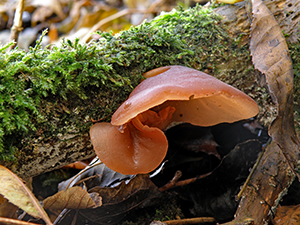 |
| Auricularia mesenterica | on dead ?elm | ||
| Botryobasidium aureum | on dead wood | ||
| Coprinus micaceus | Glistening inkcap | on dead wood |
|
| Daldinia concentrica | cramp ball | on dead ash | |
| Diatrype stigma | on fallen indet. branch | ||
| Hypoxylon multiforme | Birch woodwart fungus | on dead birch | 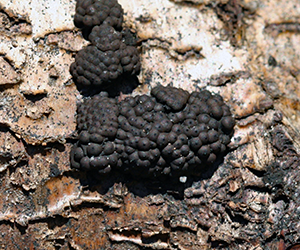 |
| Langermannia gigantean | giant puff ball | ||
| Macrolepiota rhacodes | |||
| Piptoporus betulinus: Also known as the Birch Polypore and Razorstrop Fungus. The first name indicates its usual habitat, the second one reflects the use in Victorian times of this fungus to sharpen cut-throat razors in the absence of leather strops. Image here from Toll Wood | Birch Polypore, Razorstrop Fungus | on dead birch | 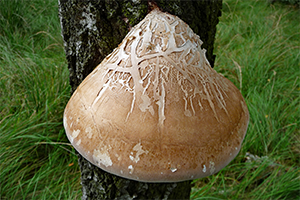 |
| Pluteus cervinus | Deer shield | on dead wood |  |
| Pluteus salicinus | Willow shield? | on dead ?elm wood | 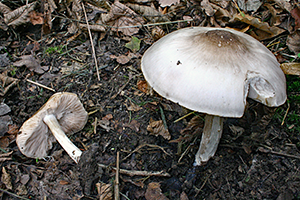 |
| Psathyrella candolleana | on dead wood | ||
| Psathyrella multipedata | |||
| Rhytisma acerinum | tar spot | on sycamore leaves | |
| Xylaria polymorpha | on dead wood | ||
AGM & Speaker - 28 October
"Lord Nelson: Episodes from a Crowded Life". Guest speaker Mrs Anthea Bryant. 2005 is the two hundredth anniversary of the Battle of Trafalgar.

